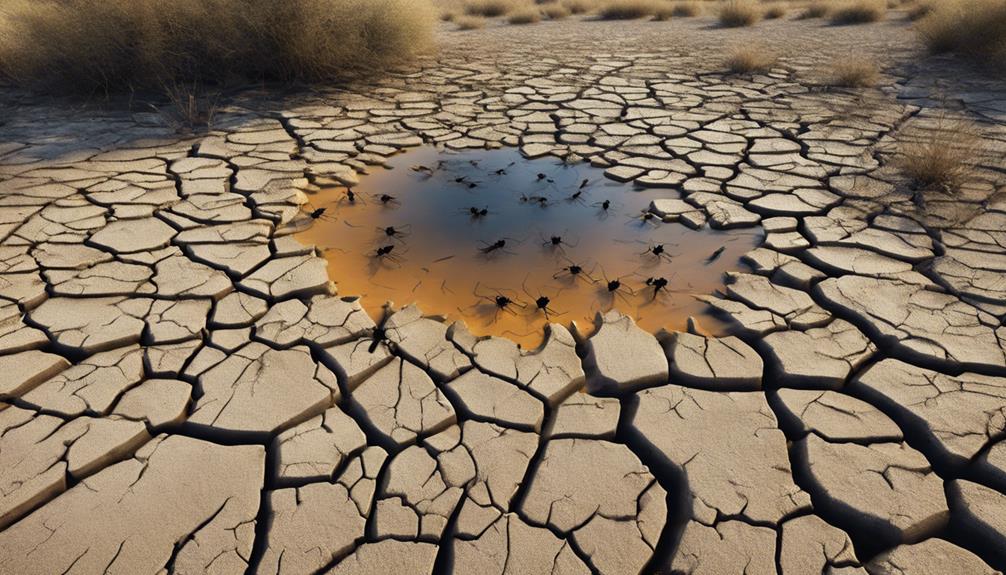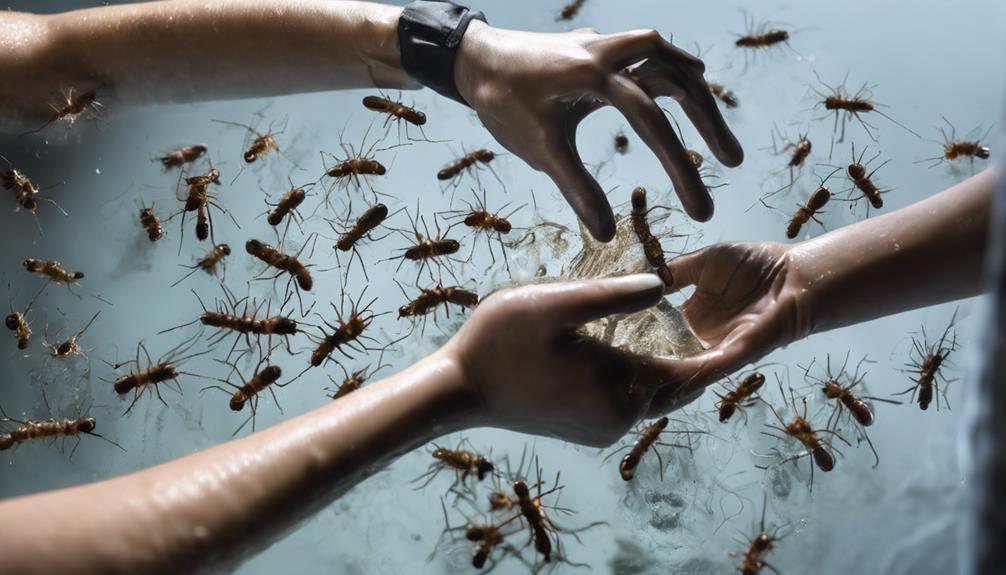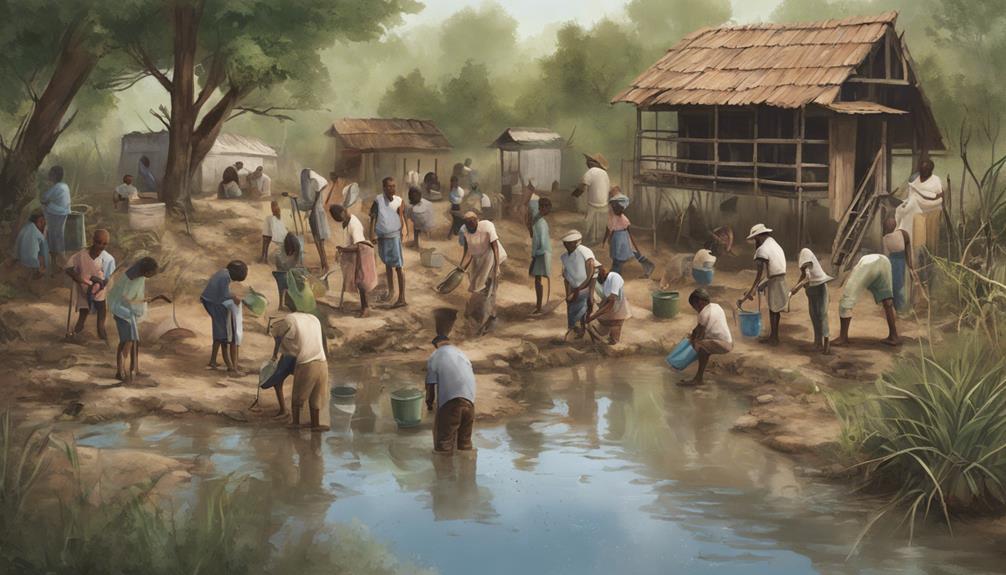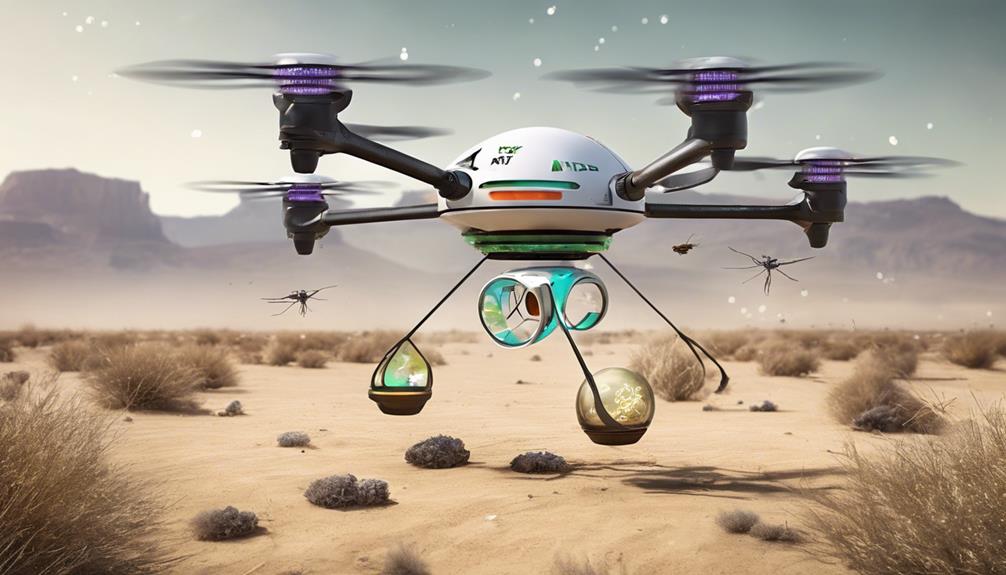Balancing environmental concerns in mosquito control and water conservation is vital for safeguarding public health and ecosystem integrity. Mosquitoes in wetlands can spread diseases and disrupt the ecosystem, requiring effective population control strategies. By utilizing natural predators, like dragonflies, and implementing eco-friendly larvicides, such as Bti, a balance between mosquito control and ecosystem health can be achieved. Managing wetlands carefully and involving the community in control efforts are essential. Remember, understanding the impact of mosquito breeding on water conservation is key to making informed decisions for sustainable management practices.
Key Takeaways
- Managing wetlands carefully preserves biodiversity while controlling mosquito populations.
- Implement eco-friendly larvicides like Bacillus thuringiensis israelensis (Bti).
- Consider impacts on non-target species during mosquito control efforts.
- Utilize natural predators like dragonflies for efficient mosquito management.
- Enhance integrated pest management techniques for sustainable mosquito control.
Impact of Mosquitoes on Water Conservation

Mosquitoes in wetlands have a significant impact on water conservation efforts by posing health risks to water users and requiring the implementation of targeted mosquito control measures. In these habitats, various mosquito species thrive, some of which are vectors for diseases such as malaria, dengue fever, and Zika virus. This poses a substantial threat to individuals utilizing wetlands for recreational activities or as a water source. The environmental impacts of extensive mosquito breeding in wetlands can disrupt the delicate balance of the ecosystem.
To address these challenges, effective mosquito control strategies need to be implemented. However, the application of control measures in wetlands is a topic of debate due to concerns about the potential ecological consequences. Integrated mosquito abatement approaches that consider the specific wetland type and mosquito species present are essential for balancing effective control with minimal environmental impact. Educating the public on the importance of wetlands conservation and proper mosquito control practices is vital for ensuring the sustainability of these valuable ecosystems.
Ecosystem Effects of Mosquito Breeding
Draining and refilling urban wetlands for mosquito control can have a significant impact on the populations of aquatic macroinvertebrates and mosquito larvae. When wetlands are drained, there’s a noticeable increase in the abundance of aquatic macroinvertebrates in these areas compared to undrained wetlands. This shift in macroinvertebrate populations highlights the direct effect of draining on the ecosystem.
Additionally, the drained wetlands become prime breeding grounds for mosquito larvae, as they prefer the altered conditions brought about by the draining process. Over time, the disparaties in macroinvertebrates and mosquito numbers tend to diminish post-draining activities, suggesting a gradual restoration of balance in the ecosystem.
It is essential to carefully manage wetlands for mosquito control while considering the broader implications for ecosystem health. Balancing the need for mosquito population control with conservation efforts is critical to prevent unintended consequences on the delicate ecological equilibrium of wetland ecosystems. Understanding these ecosystem effects of mosquito breeding is important for making informed decisions that prioritize both public health and environmental preservation.
Strategies for Mosquito Population Control

Utilize natural predators, such as dragonflies, to control mosquito populations effectively.
Implement larvicides like Bacillus thuringiensis israelensis (Bti) to prevent mosquito breeding and reduce disease transmission risks.
These strategies offer targeted approaches that consider both ecological balance and public health concerns.
Natural Predators for Mosquitoes
Among the various strategies employed for controlling mosquito populations, harnessing natural predators such as dragonflies emerges as a pivotal approach due to their effectiveness in both nymph and adult stages.
Dragonfly nymphs are known predators of mosquito larvae, contributing greatly to reducing mosquito populations. Wetlands rich in aquatic biodiversity, which support predator species like dragonflies, are essential in this regard. Studies have shown that higher aquatic biodiversity correlates with lower mosquito larval numbers.
Through integrated pest management techniques, the impact of different predator species on mosquito populations is being studied to enhance control strategies. By utilizing these natural predators, there’s potential to decrease reliance on chemical controls for mosquitoes, promoting a more sustainable and environmentally friendly approach to mosquito population management.
Larvicides to Prevent Breeding
To effectively manage mosquito populations, the use of larvicides such as Bacillus thuringiensis subsp. israelensis (Bti) is an essential strategy to prevent breeding in water bodies. Bti is highly regarded for its environmental safety and specificity in targeting mosquito larvae, minimizing harm to non-target organisms.
However, continual monitoring for resistance to Bti is imperative due to its persistence in the environment and the potential development of resistance. In conservation areas, where preserving biodiversity is crucial, considering alternative mosquito control methods becomes essential to mitigate any adverse effects on non-target organisms.
To ensure the efficacy and environmental safety of larvicides like Bti, it’s critical for unbiased entities to conduct regular monitoring and assessments.
Balancing Public Health and Environmental Concerns
Effective management of wetlands for mosquito control requires a delicate balance between safeguarding public health and preserving ecosystem biodiversity. When implementing mosquito management strategies in wetlands, it’s essential to take into account the potential impacts on non-target species and overall ecosystem health. Urban wetlands, in particular, face a challenge in balancing public health concerns related to mosquito-borne diseases with conservation goals.
Draining and refilling urban wetlands can have a significant effect on mosquito larvae populations and aquatic macroinvertebrates, disrupting the delicate ecological balance.
Routine maintenance and management practices in urban wetlands play an important role in addressing both public health risks and environmental conservation needs. By understanding the complex ecological interactions within urban wetlands, informed decisions can be made to effectively manage mosquito populations while minimizing harm to the ecosystem. This balancing act is crucial for ensuring the well-being of both human populations and the environment in the face of mosquito-borne disease threats.
Sustainable Mosquito Control Methods

You can explore sustainable mosquito control methods that encompass eco-friendly approaches and natural repellent options.
Implementing strategies such as Bacillus thuringiensis subsp. israelensis (Bti) bioinsecticide can target specific mosquito populations effectively while minimizing resistance development risks.
Tailoring integrated pest management techniques to diverse wetland environments and monitoring mosquito populations using sensitive bioassays are key components for successful and sustainable mosquito control.
Eco-Friendly Mosquito Control
Implementing sustainable mosquito control methods, such as biological control utilizing natural predators like dragonflies, is essential for reducing reliance on chemical insecticides and minimizing environmental impact.
Eco-friendly larvicides like Bacillus thuringiensis subsp. israelensis (Bti) offer targeted control against mosquito larvae while causing minimal harm to non-target species.
Integrated pest management strategies, combining various approaches, effectively manage mosquito populations while mitigating environmental impacts.
By monitoring mosquito larvae in water bodies, tailored and sustainable control measures can be implemented, ensuring efficient mosquito population management.
This pivotal approach is vital for maintaining ecosystem health and biodiversity in sensitive wetland habitats, highlighting the importance of harmonizing environmental preservation with effective mosquito control measures.
Natural Repellent Options
Natural repellent options like citronella, eucalyptus, and lavender oils provide sustainable means of controlling mosquitoes without resorting to harmful chemicals. Citronella candles and torches not only add ambiance to outdoor spaces but also offer protection against mosquitoes.
Plant communities can be enhanced by incorporating mosquito-repelling herbs such as basil and mint, which naturally deter these pests. Essential oils like lemon eucalyptus have been proven to be as effective as DEET in repelling mosquitoes, offering a natural alternative for mosquito control.
Utilizing these natural repellents not only helps in managing mosquito populations but also contributes to minimizing environmental impact and promoting sustainable mosquito control practices.
Importance of Monitoring Breeding Sites
Monitoring breeding sites plays a critical role in identifying and eliminating potential mosquito breeding grounds. By conducting regular surveillance of breeding sites, you can effectively implement targeted control measures to curb mosquito populations and reduce the risk of mosquito-borne diseases like West Nile virus. Here are three key reasons why monitoring breeding sites is essential:
- Early Intervention: Identifying stagnant water sources early on allows for prompt action to prevent mosquito breeding, disrupting their life cycle before populations grow substantially.
- Preventive Measures: Monitoring breeding sites enables you to proactively address potential breeding grounds, reducing the need for reactive and widespread mosquito control efforts.
- Disease Prevention: By targeting breeding sites, you can mitigate the risk of mosquito-borne diseases, safeguarding public health and promoting a safer environment for communities.
Role of Larvicides in Mosquito Management

To effectively manage mosquito populations, understanding the role of larvicides such as Bacillus thuringiensis subsp. israelensis (Bti) is essential in implementing targeted control measures. Larvicides like Bti are pivotal in controlling mosquito larvae in water bodies. Bti is favored for its environmentally safe nature and specificity in targeting mosquito larvae, making it an effective tool in mosquito management programs.
However, continuous monitoring for resistance to Bti is crucial due to its long-lasting effects and the potential development of resistance in mosquito populations. Integrated pest management strategies that incorporate larvicides such as Bti can greatly reduce the reliance on chemical control methods, promoting a more sustainable approach to mosquito management.
Proper surveillance of mosquito larvae in water bodies is paramount for the successful implementation of larvicide-based control measures, ensuring that mosquito populations are kept in check while minimizing environmental impact. By integrating larvicides like Bti into mosquito management programs, a balanced and effective approach to controlling mosquitoes can be achieved.
Preserving Wetland Ecosystems in Control Measures
In the context of integrated mosquito management, the preservation of wetland ecosystems plays a critical role in maintaining the delicate balance between effective control measures and environmental conservation. When considering wetland draining for mosquito control, it’s essential to acknowledge the impact on aquatic macroinvertebrates and mosquito larvae populations.
Drained wetlands often exhibit a higher abundance of macroinvertebrates compared to undrained counterparts, highlighting the intricate relationship between wetland health and mosquito control efforts. However, the presence of mosquito larvae mainly in drained wetlands can disrupt the balance of species post-draining, necessitating a careful approach to wetland management.
- Wetland draining affects aquatic macroinvertebrates and mosquito larvae populations.
- Drained wetlands show increased abundance of macroinvertebrates.
- Mosquito larvae mainly inhabit drained wetlands, impacting post-draining species distribution.
Urban wetland management practices must consider potential effects on non-target species and public health, emphasizing the importance of implementing conservation measures to safeguard ecosystem integrity while addressing mosquito control needs effectively.
Community Collaboration for Mosquito Control

To address the subtopic of ‘Community Collaboration for Mosquito Control,’ it’s essential to highlight the significance of collaborative pest management strategies.
Local volunteer initiatives play an important role in monitoring mosquito populations and identifying breeding sites within communities.
Public health partnerships are necessary for implementing effective control measures and enhancing public awareness of the importance of mosquito control for disease prevention.
Collaborative Pest Management
Engaging the community in collaborative pest management efforts enhances the effectiveness of mosquito control strategies and promotes shared responsibility for environmental health. Collaborative pest management involves community participation in monitoring and addressing mosquito populations, aiming to reduce risks of mosquito-borne diseases and promote environmental health.
By working together with local authorities, communities can increase awareness about mosquito control strategies and foster a sense of shared responsibility. Implementing integrated pest management techniques collaboratively enables effective and sustainable mosquito control practices.
- Community participation is key in monitoring and addressing mosquito populations.
- Collaborative approaches aim to reduce risks of mosquito-borne diseases.
- Integrated pest management techniques can be effectively implemented through community collaboration.
Local Volunteer Initiatives
Local volunteer initiatives actively contribute to community collaboration efforts for mosquito control by engaging in essential tasks such as monitoring breeding sites and implementing eco-friendly larvicide treatments. These volunteer-driven initiatives are pivotal for sustainable mosquito management practices, focusing on minimizing environmental impact while effectively reducing mosquito populations.
By involving volunteers in mosquito control programs, communities can work together to address mosquito-related challenges and promote public health. Volunteers play a key role in raising awareness about mosquito-borne diseases and educating the community on preventive measures.
Through their dedication and commitment to eco-friendly management strategies, volunteers help protect local ecosystems and contribute to the overall well-being of the community. Joining volunteer initiatives for mosquito control fosters a sense of belonging and shared responsibility for environmental conservation and public health.
Public Health Partnerships
Public health partnerships play a crucial role in fostering effective community collaboration for mosquito control efforts. Collaborative initiatives with local communities enhance public awareness and participation in mosquito management. Engaging with community members helps in identifying mosquito breeding sites and implementing control measures. Partnerships with public health agencies enable the development of targeted strategies for mosquito-borne disease prevention.
- Public health partnerships enhance public awareness and participation in mosquito control efforts.
- Community collaboration aids in identifying and addressing mosquito breeding sites effectively.
- Targeted strategies developed through partnerships with public health agencies optimize mosquito control measures.
Future Directions in Mosquito Control

Incorporating advanced research findings and collaborative efforts with disease specialists, the future directions in mosquito control will prioritize a holistic approach towards managing mosquito populations effectively.
Thorough data collection in 2022 will inform targeted strategies, focusing on the intricate relationship between biodiversity and mosquito-borne diseases to optimize control measures. By partnering with disease researchers, protocols for precise disease risk assessment related to mosquito populations will be developed, enhancing preemptive public health interventions.
Ongoing monitoring of Culex mosquito larvae for West Nile virus transmission underscores the proactive stance on mitigating disease risks. In tandem, protocols integrating natural predators such as dragonflies and employing integrated pest management techniques are being refined to guarantee efficient management of mosquito populations.
These advancements signify a concerted effort to address the complexities of mosquito control while safeguarding public health and environmental balance.
Frequently Asked Questions
What Are the Challenges of Balancing Mosquito Control With the Preservation of Aquatic Ecosystems?
When balancing mosquito control with ecosystem preservation, challenges include biodiversity impact, habitat disruption, water quality, predator-prey dynamics, disease transmission, and ecosystem resilience. Consider these factors to manage mosquitoes effectively while safeguarding aquatic environments.
How Do Mosquitoes Balance the Ecosystem?
You may wonder how mosquitoes balance the ecosystem. Imagine this: just like referees in a game, mosquitoes keep things in check by providing food for predators, filtering water, controlling populations, fostering biodiversity, and aiding in nutrient cycles.
Would Eliminating Mosquitoes Affect the Environment?
Eliminating mosquitoes could have significant impacts on the environment, affecting insect populations, biodiversity, water quality, ecosystem disruption, wildlife habitat, and even climate change. Consider the intricate web of life that relies on these tiny creatures.
Is Mosquito Control Bad for the Environment?
You might wonder if mosquito control harms the environment. The truth is, environmental impact is significant. Biodiversity preservation, natural predators, chemical pollutants, water quality, and ecosystem health are all affected by mosquito control efforts.




